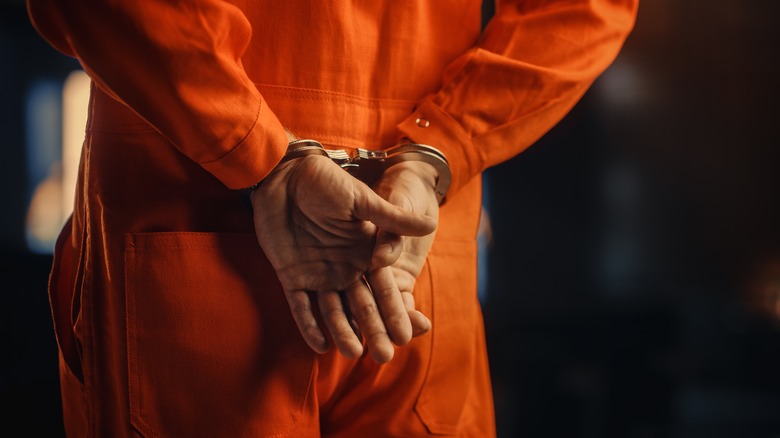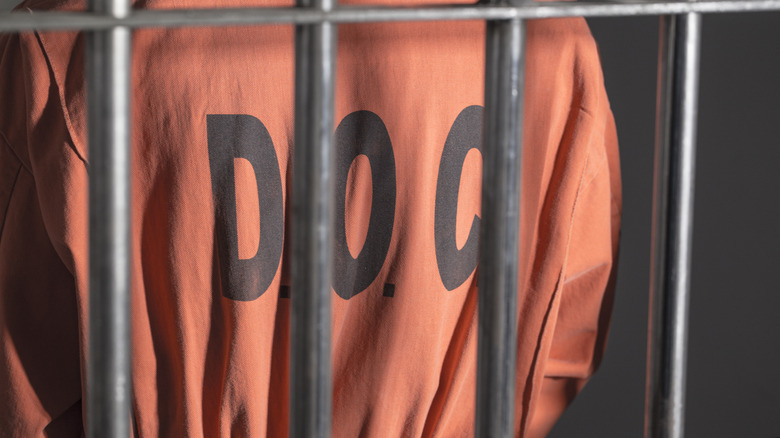The Real Reason Prisoners Wear Orange
Prison uniforms are instantly recognizable, so much so that they have become a popular choice for costume parties. While in popular culture, prison settings and uniforms have been exploited to great effect: think, for instance, of Elvis Presley's iconic performance of "Jailhouse Rock," with the King of Rock 'n' Roll and his scores of backing dancers gyrating in striped shirts and dark jackets marked with their prison numbers.
But as any viewer of courtroom TV or more recent prison dramas knows, in recent decades black and white stripes have largely become a thing of the past, and the distinctive traditional outfits first used in the 19th century were replaced in many U.S. prisons with bright orange jumpsuits or scrubs. Much of the criticism toward traditional prison outfits argued that they were dehumanizing and a source of shame for many prisoners. However, it's also arguable that such criticisms could indeed be made about modern orange outfits. While orange prison uniforms are perhaps just as ridiculous as their black and white predecessors, there are a number of practical reasons underpinning their use, with experts convinced that brighter colors help improve prison security.
A distinctive look
The practical reasons for the use of regulation orange outfits in the U.S. prison system include the fact that bright colors make it easier for inmates to be spotted at a distance, meaning that they are more likely to be seen by officers in the case of their escaping from prison. Indeed, prisoners typically only wear orange when the risk of escape is high, such as during a court appearance or when they are being transported between prison wings or institutions. The rest of the time, prisoners typically wear darker work clothes.
However, there has been a notable pushback against orange jumpsuits and scrubs in U.S. prisons in the 21st century. As The New York Times reported in 2000, single-block-color jumpsuits — as opposed to striped uniforms — have sometimes led to escaped prisoners being mistaken for utility, sanitation, or construction workers, making it far less likely that they'll be reported and apprehended. On another note, the association of orange jumpsuits has changed over time. Their use by the U.S. to dress imprisoned terror suspects at the notorious Guantanamo Bay detention center prompted the Islamic militant group ISIS to dress their own prisoners, who are often executed, in similar outfits in an attempt to draw equivalency between both sides.
No longer the new black
Though orange jumpsuits and scrubs have long been the most recognizable uniform of prisoners in the United States, the pushback against them in recent years has seen prisons across the country looking for alternative outfits for their inmates to wear. Several institutions have reportedly reverted back to horizontally striped outfits that are familiar from old movies and news footage, which they say make it easier for escapees to be identified. However, nowadays, prisons often opt for colored stripes to maintain the benefit of bright colors for catching the eye at a distance, with different colors for low, medium, and high-security inmates. In 2014, a sheriff in Michigan had reportedly grown convinced that the Netflix series "Orange is the New Black" had made orange fashionable among inmates and had decided to revert to black and white, according to Sky News. "Until black-and-white horizontal stripes become the new black, we are changing our uniforms," Sheriff William Federspiel said.
In 2010, it was reported that in Magnum, Oklahoma, Greer County Sheriff Devin Huckabay had begun issuing his county jail detainees with hot pink jumpsuits. As well as the color reportedly making it easy to track inmates, Huckabay told News on 6 that he believed pink to be a deterrent for many local criminals, who would be reluctant to wear the color in jail.


